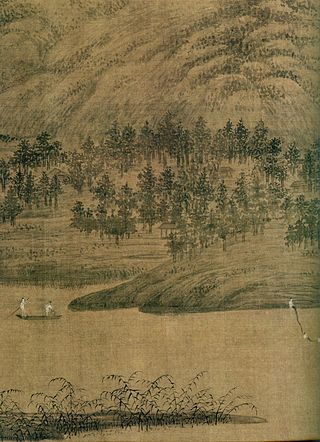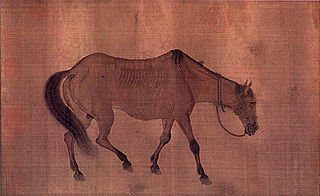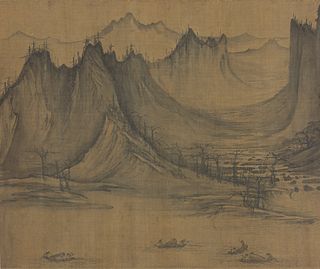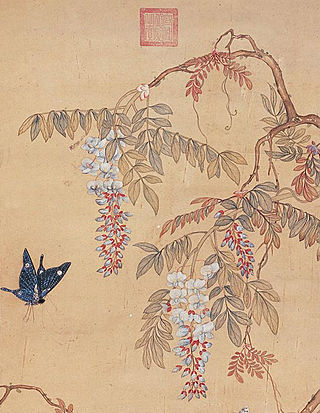
Dong Yuan was a Chinese painter.

Guo Xi was a Chinese landscape painter from Henan Province who lived during the Northern Song dynasty. One text entitled "The Lofty Message of Forest and Streams" is attributed to him. The work covers a variety of themes centered on the appropriate way of painting a landscape. He was a court professional, a literatus, well-educated painter who developed an incredibly detailed system of idiomatic brushstrokes which became important for later painters. One of his most famous works is Early Spring, dated 1072. The work demonstrates his innovative techniques for producing multiple perspectives which he called "the angle of totality." This type of visual representation is also called "Floating Perspective", a technique which displaces the static eye of the viewer and highlights the differences between Chinese and Western modes of spatial representation.
Shide was a Tang dynasty Chinese Buddhist poet at the Guoqing Temple on Mount Tiantai on the East China Sea coast; roughly contemporary with Hanshan and Fenggan, but younger than both of them. As close friends the three of them formed the "Tiantai Trio". Shide lived as a lay monk, and worked most of his life in the kitchen of Guoqing Temple.
The Four Wangs were four Chinese landscape painters during the Qing dynasty in the 17th century, all with the surname Wang. They are best known for their accomplishments in shan shui painting.

Qiu Ying was a Chinese painter of the Ming dynasty who specialised in the gongbi brush technique.

Huang Shen (1687–1772) was a Chinese painter during the Qing Dynasty. Huang was born in Ninghua, Fujian province, to a poor family. His courtesy names were Gongshou (恭壽) and Gongmao (恭懋). His pseudonym was Yingpiaozi (癭瓢子).

Huáng Bīnhóng was a Chinese literati painter and art historian born in Jinhua, Zhejiang province. His ancestral home was She County, Anhui province. He was the grandson of artist Huang Fengliu. He would later be associated with Shanghai and finally Hangzhou. He is considered one of the last innovators in the literati style of painting and is noted for his freehand landscapes.

Ren Renfa (1254–1327), courtesy name Ziming (子明), pseudonym Yueshan Daoren, was an expert of irrigation works, artist, and a government official of the Yuan dynasty. He was born in Qinglong Town, Songjiang.

Qian Xuan, courtesy name Shun Ju (舜举), pseudonyms Yu Tan, Xi Lanweng (习嬾翁), and Zha Chuanweng (霅川翁), was a Chinese painter from Huzhou (湖州), the present day Wuxing District in Zhejiang. He lived during the late Song dynasty and early Yuan dynasty.

Hua Yan simplified Chinese: 华嵒; traditional Chinese: 華嵒; pinyin: Huà Yán; Wade–Giles: Hua Yen; courtesy name Qiu Yue (秋岳), sobriquets Xinluo Shanren (新罗山人), Dong Yuan Sheng (东园生), Buyi Sheng (布衣生), Ligou Jushi (离垢居士)and Bosha Daoren (白沙道人) was a Chinese painter during the Qing dynasty. He was born in Shanghang (上杭) Fujian province and lived in Yangzhou and later in Hangzhou. Yan's work is within the tradition of the Yangzhou school and is often named as one of the Eight Eccentrics of Yangzhou.

Xu Daoning was a Chinese painter of the Northern Song Dynasty (960–1279) from Chang'an or Hejian. He started out life by selling medicine prescriptions in Kaifeng. While selling prescriptions, he also began painting nature scenes in the style of Li Cheng. After gaining popularity he took up painting murals for Chinese nobles. His most notable work is Fishermen's Evening Song.

Cui Bai was a prominent Chinese painter of the Northern Song Dynasty (960–1279). A native of Anhui Province, Cui was best known for paintings of animals and plants. At some point during his life, he traveled to the capital of Kaifeng to seek employment as a court artist, and was accepted by Emperor Shenzong of Song, who admired his works. He became a renowned artist of Shenzong's court, but gained an awkward reputation for his often eccentric behavior.

Zhu Derun (1294–1365), Zemin (泽民) by style name, Suiyang Shanren (睢阳山人) by pseudonym, was a Chinese painter and poet in Yuan Dynasty. He was a native of Suiyang, Henan Province, and later lived in Suzhou. He was at one time the editor at the national academy of history, and also served as academic director in Zhendong Province, and supervisor in Jiangzhe Province.

Xi Gang ; 1746-1803 was a renowned seal carver and painter in Qing Dynasty. He was born in Qiántáng. His style name was Chunzhang (纯章) and his pseudonym was Tiesheng (铁生). Other names include Hezhusheng (鹤注生) and Mengquan Waishi. His specialty was in painting landscapes. His seal carving method was similar to that of Ding Jing (丁敬), though somewhat cleaner and sharper. His style is representative of the Southern School. He was also talented in prose and calligraphy.

Wang Yi ; ca. (1333-unknown) was a Chinese painter of human figures during the Yuan Dynasty (1271–1368). His specific date of death is unknown.

Wang Yuan ; was a Chinese landscape painter during the Yuan Dynasty (1271–1368). His specific dates of birth and death are not known.

Wang Jian ; c. 1598–1677 was a Chinese landscape painter during the Ming dynasty (1368–1644) and Qing dynasty (1636–1912).

Xu Xi )(died before 975), was a Chinese painter in the Southern Tang kingdom during the Five Dynasties and Ten Kingdoms period.
Juran was a Chinese landscape painter of the late Five Dynasties and Ten Kingdoms and early Northern Song periods.

Li Song was a Chinese imperial court painter in the Song Dynasty.


















